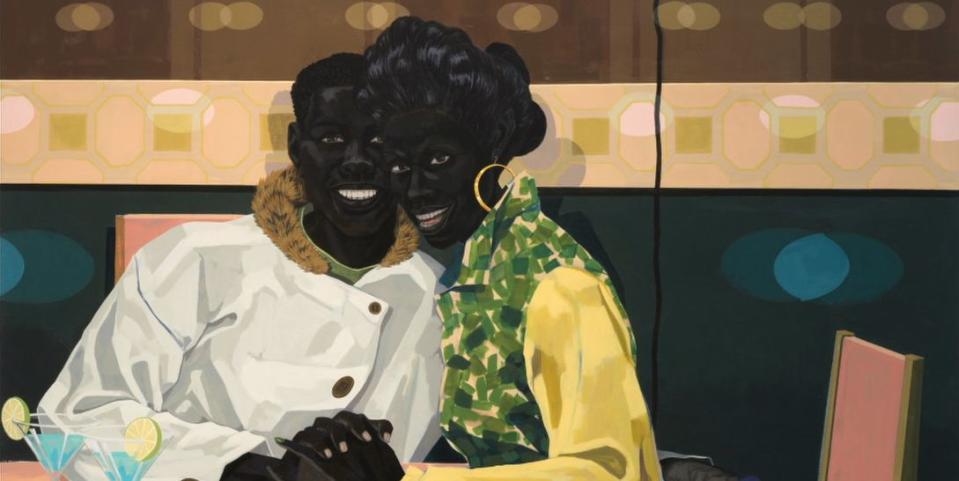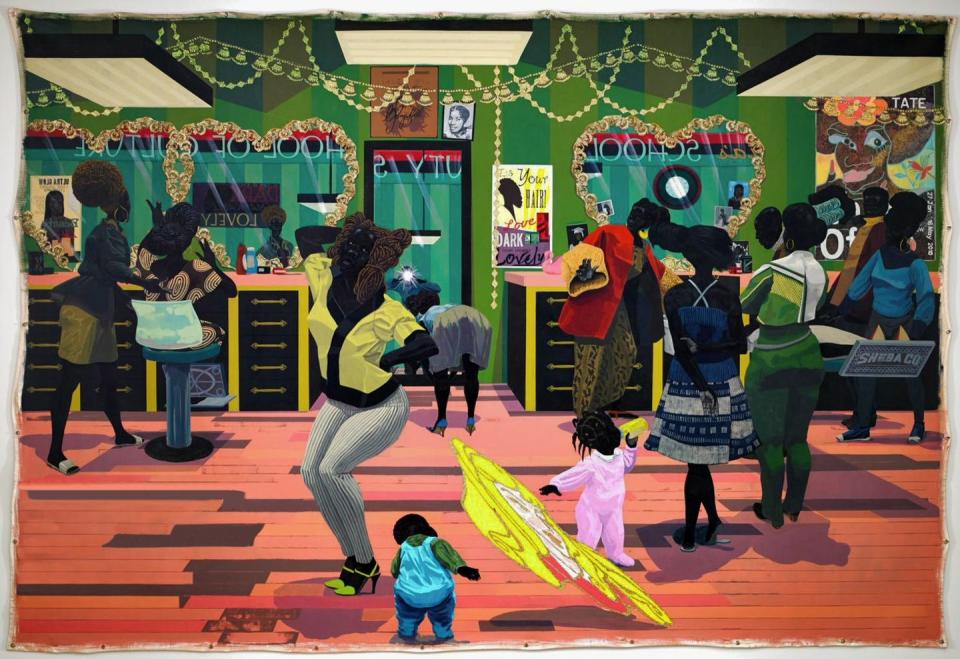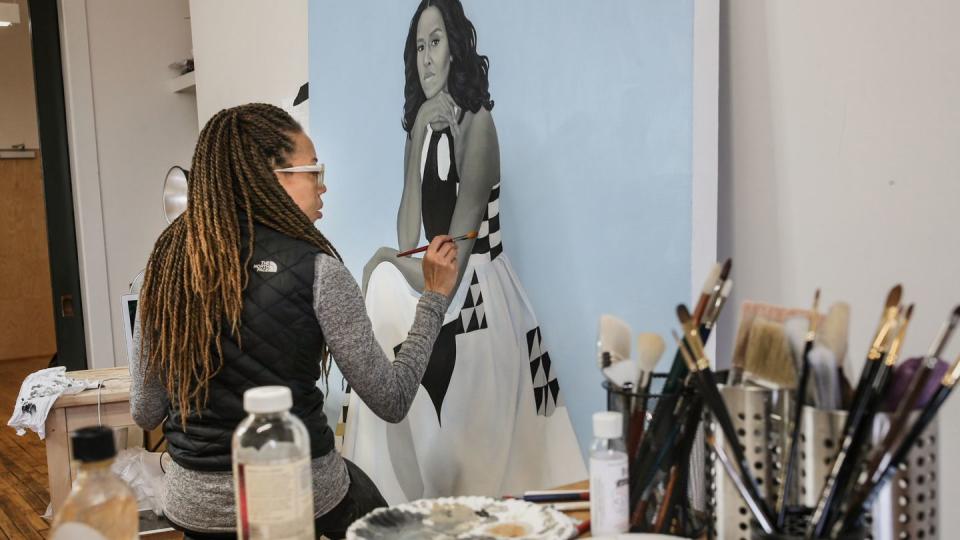"Art is a Way to Exert Power": On HBO's "Black Art: In the Absence of Light"


The new HBO documentary Black Art: In the Absence of Light highlights the development of art over the past two centuries, using modern Black art scholar David C. Driskell's landmark 1976 exhibition at the Los Angeles County Museum of Art as a point of departure. Executive produced by Henry Louis Gates with consulting by Thelma Golden, the film retroactively examines the history of Black art making that has long been dismissed by the white mainstream. The light in the title can be read as a euphemism for the white gaze, as well as the journey from private art making and disregard to success and visibility.
The arc of works discussed ranges from David Drake’s pottery from the early 19th century to Theaster Gates's conceptual approaches to pottery and his impact on place keeping in the highly gentrified Chicago, one of America’s Blackest cities. We are swiftly taken through the years of contemporary Black art, from the sexism experienced by Black women artists among institutions and their own Black male peers to the failures and successes of landmark exhibitions, like "Harlem on My Mind" at the Metropolitan Museum of Art, "Two Centuries of Black American Art" at the Los Angeles County Museum of Art, and "Black Male" at the Whitney Museum.

Master painter Kerry James Marshall offers this at the start of the documentary: “I have a palette that is as complex and as broad and as range as any other color that’s on the spectrum.” Marshall emphasizes the beauty of Blackness when it is thrown against more Blackness; a practice of being self-referential and inter-relational. What do Black folks do in the absence of whiteness? Marshall’s ethos as a portrait painter has contended with this question throughout his 30-plus-year career. Commentary by artists such as Betye Saar, Radcliffe Bailey, and Richard Mayhew remind us of the importance of legacy, inheritance, spirituality, and intuition that endure with and without a widespread audience.
The documentary also marks the trajectory from having to insist on the cultural value of Black art to the market interest of it today—the transition from moving out of the absence of light into sometimes overwhelming marketability. Contemporary collector of Black art, rap mogul, and self-proclaimed disruptor Swizz Beatz and collector Bernard Lumpkin speak of a more conscious approach to collecting. Feminist scholar Michele Wallace insists that the collecting work of Beatz and his wife, Alicia Keys,“are about the culture.” The film goes on to name other hip-hop moguls who have done the work of collecting (and rapping) about contemporary art, tying the increasing interest in Black art to this exposure via pop culture.
As Beatz explained his collecting interests, I considered the recent rise of contemporary figurative painter Amoako Boafo. His work has been catapulted into the mainstream art market in a way that could be seen as predatory and exploitative. Collectors and consultants instigated the increase in value of his work to manipulate secondary markets, ultimately benefiting collectors disproportionately more than the artist himself. Similarly, Marshall made headlines in 2018, when a work of his that was sold by the artist for $25,000 in 1997 was sold 11 years later for $21.1 million, with no direct compensatory benefit for the artist. The presence of Beats and Lumpkin, and their declaration to support Black artists, presents a somewhat promising approach, but the glaring and burgeoning tensions that exist in the unregulated art market go unaddressed in the documentary.
In addition to collectors, mainstream museums have made concerted efforts during the era of Black Lives Matter to collect more work by Black artists. This is ostensibly to redress and correct the ahistorical gaps of African-American art in their collections. But artist Fred Wilson, also featured in the film, has consistently interrogated these structures of invisibility. Instead, he is perpetually interested in how the counter-narratives of Americana can be brought to light through the work of Black art makers.
And then, there are institutions that have supported Black artists since their inception, such as The Studio Museum in Harlem and historically Black colleges. Howard, Fisk, and Hampton Universities, as well as the Atlanta colleges and universities, are named in the documentary in a small segment. But these institutions deserve to be positioned as the crux of the storyline, since these spaces have enabled the legacy of Black art as we know it.
These tensions are perhaps best highlighted in the official portraits of President Barack Obama and First Lady Michelle Obama, which take center stage in the documentary. The portraits of the First (Black) Man and Lady, made by Kehinde Wiley and Amy Sherald respectively, are arguably two of the most famous paintings by Black artists. They are starkly distinguished in the documentary against a large collection of white male portraits of previous presidents—drab and dreary with muted colors and very little light. The optics of the Obama couple, rendered in Wiley’s distinct hyperrealistic portraiture with a lush green background and Sherald’s signature gray tone against easter-egg blue, suggest vitality, strength, even a holiness about them.

The Obamas’ portraits are a microcosm of the arc of Black art in the last 30 years. The belief of post-racialism and post-Blackness has defined and influenced much of the contemporary art we are seeing today, as Black artists began to emerge more profoundly into the mainstream during the 1990s. These artists insisted on being seen not just as Black artists, but as artists in general. Post-racialism is the promise of working to move beyond the perils of the Black condition in America, an achievement of Black acceleration and exceptionalism; when transcending race was aspirational and thought of to be wholly possible. This belief developed and climaxed as the United States elected its first Black president. In these portraits, the subjects captivate as they did on election night 2008. Looking at them, one could be convinced that the violence, disenfranchisement, and erasure against Black life in this country could be reformed and redressed. Yet, 13 years later, we recognize the ruse of the myth of race transcendence, no matter how many of us are made visible in the light.
Seeing those portraits, I think about Sarah Elizabeth Lewis, a commentator in the documentary. “Art is a way to exert power,” she declares, which leads me to question, What does this power mean in the wake of a presidential election that barely escaped the grip of fascism and a new president who insists on “unity” as white supremacists terrorize? How can this power in art be used as leverage during an epoch of disaster capitalism, when works by Black artists are being sold in secondary markets for 10 times what they were sold for in the first?
The most gratifying aspect of this documentary is the subtle eulogizing of scholar and artist David C. Driskell, who we lost in April of 2020. Throughout, he provides rich critiques of contemporary Black artists. Driskell speaks of Theaster Gates as both an artist and a preacher given his invigorating cadence that is renowned. Gates sermons toward the end of the documentary in an attempt to foreshadow what is to come in contemporary Black art. “We’re being trained and conditioned to only make when there is a light,” he says. “Are you willing to make in the absence of light?” he probes, presumptively to a younger generation of artists. And yet, with all his zeal, his prompt still evokes trepidation and query: Which direction should Black artists take in the newfound light that can sometimes be too blinding to locate the woodshed?
Black Art: In the Absence of Light is a comprehensive offering that traces the history of Black art. However, the film leaves something more to be desired about where the future of Black art is headed. There is no attention paid to new medium forms, work made by people with multiple genders and sexualities, and the fact of art being made out of what Elizabeth Alexander has termed the "Trayvon (Martin) Generation." In response to this concise documentary and Gates's demand, I ask, given the hypervisibility and marketability of Black art, paired with the insistence that Black lives, too, are valuable, how does this affect how art by Black artists is made?
You Might Also Like

